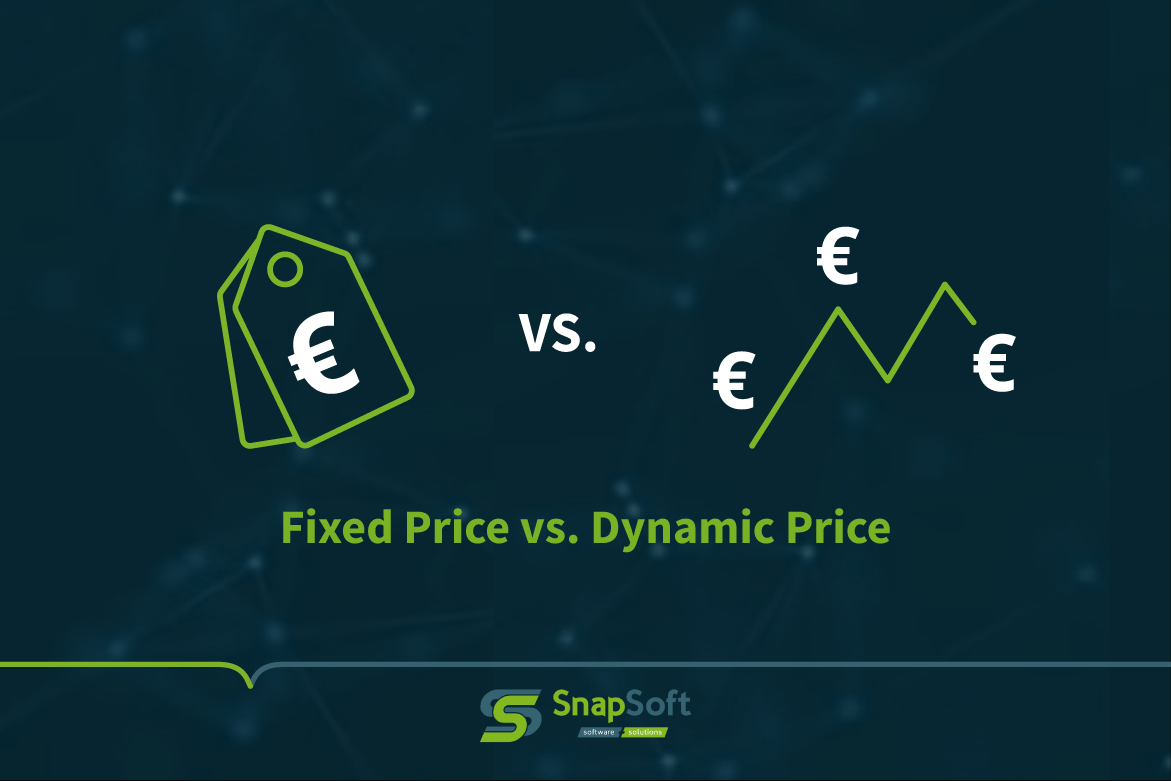The german saying “Geiz ist geil” – “Stinginess is cool” has had its day as a shopping philosophy: the majority of consumers have said goodbye to dumping prices and are quite prepared to pay the appropriate price for high quality. Nevertheless, price is still one of the most important instruments in e-commerce. It determines whether an offer is even considered for purchase or not. Choosing the right pricing strategy can therefore have a big impact on success or failure for your online business. In this blog post, we address the question of where the differences between fixed and dynamic prices lie and which principle is right for your business.
The fixed price: Whatever lasts will always be good?

With fixed prices, the name tells it all: once defined, it is constant and retains its validity at least over a certain period of time. This principle is characterized above all by its simplicity. Moreover, it can just as easily be sold to customers as a value promise, because stable prices have long ceased to be a matter of fact.
However, it is not certain that what always lasts will always be good in the end, because a fixed price also brings with it a number of disadvantages. It deprives you of the opportunity to secure a competitive advantage through flexible pricing, because turning away from fixed prices does not mean dumping your own products. Static pricing is rarely done in a margin-optimized way, because you don’t sell more expensively even when the demand for your product actually allows it. Price search engines and comparison portals usually show customers the items with the best price, which is why you lose a lot of visibility compared to your competitors.
Advantages and disadvantages of fixed prices:
+ Easy to define
+ No effort to change
+ Price as value proposition
– Loss of competitive advantage
– Not margin-optimized
– Lower visibility
Dynamic prices: Constantly on the move

The counterpart to the fixed price is the dynamic price. It is variable within a certain interval, the minimum and maximum price, and can change several times a day. In e-commerce, this is particularly the case on marketplaces such as Amazon, eBay & Co. where dynamic pricing is being used more and more frequently. Here, different suppliers constantly outbid and undercut each other for one and the same product.
Dynamic pricing can hardly be implemented manually. Especially not if your product range includes a large number of items. Even if you have only a few products, you would only be running behind the development of the market and would have to invest a lot of time in order for your prices to keep up with the changes of your competitors.
The effort is probably the biggest weakness of dynamic pricing, as it is almost impossible to manage without automated tools. That being said, dynamic prices do offer a number of benefits. For example, they can be used to win the Amazon BuyBox or eBay’s Super Price more frequently. In general, the flexible pricing model can lead to an increase in sales. If demand is particularly high, dynamic prices allow you to sell at better conditions. Market-oriented pricing also makes your products appear more often in price search engines. In sales, if demand is particularly high, dynamic prices allow you to sell at better conditions. Market-oriented pricing also makes your products appear more often in price search engines.
Advantages and disadvantages of dynamic pricing:
+ Competitive advantages
+ Margin optimization
+ Increased visibility in comparison portals
– Difficult to implement manually

Reasons for dynamic pricing
Dynamic pricing is not really new. The roots of this pricing strategy lie in the aviation industry. Nowadays, dynamic pricing is used in a variety of industries and has long since become the norm, especially in e-commerce. Three main factors have led to dynamic pricing becoming more and more established.
#1 Commerce is becoming more complex and transparent
Selling through online channels is the main source of growth for many retailers. However, the increasing use of online sales channels has greatly increased price and information transparency. Nowadays, customers can compare prices with just a few clicks. So if retailers want to stay competitive, they have to keep an eye on competitors‘ prices and adapt to the changing market environment.
#2 The amount of data is increasing more and more
The possibilities for collecting data have evolved dramatically in recent years. Data collection has exploded. The advantage of trading transparency on the customer side can likewise be played out on the supplier side by continuously capturing market data such as competitors’ prices. Moreover, with every purchase, customers leave a data trail that can be used to further optimize prices and exploit profit potential.
#3 New technologies are becoming more mature
In addition to data collection, technologies for analyzing and interpreting data have also steadily evolved. Algorithms and bots help to continuously analyze factors such as the market situation and competitors’ prices. Technologies such as machine learning are now advanced and help to further develop and constantly optimize price adjustments. In a fiercely competitive environment with narrow margins, retailers are therefore well advised to make use of contemporary technologies.
#4 Dynamic pricing is a competitive advantage
The use of dynamic pricing is on the rise, and not just because of technical developments. Setting a dynamic price provides a competitive advantage that should not be underestimated. Thanks to the flexibility of dynamic pricing, effects on the market environment can be better covered. In this way, companies can respond to fluctuations in demand and price actions of the competition in a targeted manner or determine market prices flexibly themselves and thus gain an advantage over the competition. As a rule, fixed prices do not have such a steering effect.
What criteria should a dynamic price meet?
In order for dynamic pricing to function at all, a number of requirements must be met. For example, it only makes sense if it is market-oriented. This means that you always need up-to-date market data for your price adjustments. Collecting this data is almost impossible without technical support. The time factor also plays a role. In the fast-paced world of e-commerce, the same product may cost different amounts depending on the day of the week or even the time of day. That’s why dynamic pricing should be feasible as quickly as possible.
For many retailers on marketplaces, this is a major annoyance, but (unfortunately) an undeniable fact: the rules of the game are dictated not by the sellers, but by the platform operators. For example, corporate giant Amazon charges different fees for its FBA program depending on the product category. For efficient repricing, you need to take such criteria into account and be able to react to changes as quickly as possible – the easiest way to do this is, of course, automatically.
Dynamic pricing requires:
– Current market data
– Fast realization
– Adaptability to marketplace conditions
Fixed vs. dynamic pricing: Which should you use when?

Since both pricing models have their advantages, the valid question is when to use which. The decision is primarily based on where you want to sell. In your own online store, a fixed price initially seems to be well feasible because you enjoy a lot of design freedom. However, for the vast majority of online merchants, this pricing philosophy is sooner or later softened, which is due to the fact that they compare themselves with others when running their own online store. Their own market observations always lead them to re-adjust their prices.
If you are exposed to a tense competitive situation, which is especially the case in marketplaces, dynamic pricing is more of a must rather than a freestyle. It can play to your strengths in the marketplace environment and ensure that you always sell in line with the prevailing market situation. However, you may be limited by the size of your portfolio if you don’t use a tool to automatically adjust your prices.
Fixed prices are best used when:
– You sell from your own online store
– There is little competition for your products
Dynamic prices are best used when:
– You offer your products on marketplaces
– You are facing intense competition
– You have access to automated price adjustment
Conclusion
Both fixed and dynamic pricing models have their reason to exist. The former are particularly worthwhile if you are the only seller for a product. However, since it is relatively easy to compare prices for online offers through various price search engines, more and more retailers tend to adjust their prices based on their own market observations. In marketplaces with intense competition, dynamic prices have long been the norm anyway. The reasons for this can be found in the benefits of dynamic price adjustment, which can boost sales and increase profits if demand is high enough.
About SnapSoft
SnapSoft GmbH sells software solutions that simplify business processes for e-commerce companies. SnapTrade provides online retailers with an automated repricing tool that enables dynamic price adjustment within defined price ranges on Amazon and eBay. With the integrated solution ShopSPY you will always find the best price for your online store.


